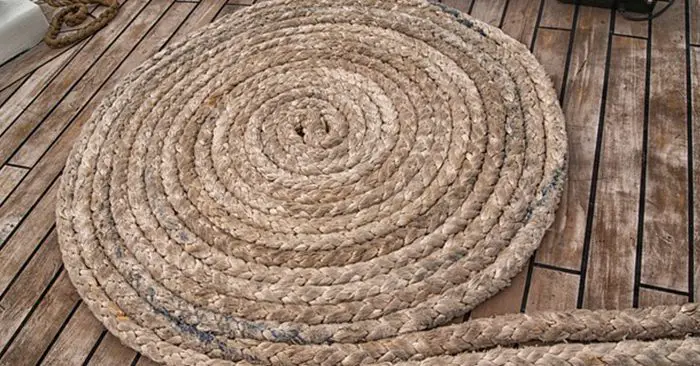SHTFPreparedness may collect a share of sales or other compensation from the links on this page.

I guess you already know that rope may be made of any long, stringy, fibrous material, but generally is made of certain natural or synthetic fibers. Furthermore, the properties and performance of any rope are reliant on the materials from which they are made. So I would like to give you a short preview of what are the advantages and disadvantages of the best known natural and synthetic fibers.
This is how you can compare the key properties of the most frequently used materials and finally choose the rope that is right for your needs.
Natural Fibers
Natural fibers are usually categorized as either hard or soft. Hard fibers are obtained from the leaves of plants, while soft fibers are obtained from the stems.
Cotton
Advantages:
- Natural cellulose fiber with high cellulose content (96%)
- High resistance to sunlight
- Absorbs moisture from the air
- Resistant to solvents and weak acids
Disadvantages:
- Flammable, they decompose at about 160°C
- Sensitive to sulfuric acid
Manila
Advantages:
- Durable
- Flexible
- Resistant to saltwater damage
- Good resistance to sunlight, it will not melt easily
- Exceptionally strong
- Visually appealing
Disadvantages:
- Shrinks when becomes wet
- Expensive
Hemp
Advantages:
- Natural, organic, biodegradable cellulose fiber – high wettability
- High permeability to air which prevents mold and rot
- High resistance
- Resistant to solvents
Disadvantages:
- Slightly flammable, sensitive to acids in general
Flax
Advantages:
- Natural, organic, biodegradable cellulose fiber
- Absorbs and easily yields moisture
- Soft-touch
- High resistance in wet condition especially
- High permeability to air which prevents mold and rot
- Burns without leaving any residue
Disadvantages:
- Sensitive to acids in general
Wool
Advantages:
- High capacity to absorb moisture from the air
- Low conductivity to heat and electricity
- The lightest natural fiber
- High elasticity and increases with humidity
- Allows UV rays
- It hardly catches fire
- Great for soundproof
Disadvantages:
- Folds easily
- Low resistance when there is humidity
- Low resistance on concentrated acids
- Attacked by moths
Synthetic Fibers
Nylon (Polyamide)
Advantages:
- Exceptional dynamic features
- Hydrophobic
- Very poor water absorption
- High resistance to chemical and biological agents
- Resistance to abrasion
- Good sunlight resistance
- Rot-resistant
- Maintains its superior strength while still being very flexible
Disadvantages:
- Does not absorb sweat
- Its strength becomes compromised when wet
- It charges electrostatically
Susceptible to degradation in high temperatures
Polyester
Advantages:
- Silky, pleasant to handle
- Insulating
- Resistant to depreciation
- Resistant to microorganisms and chemical agents
- Inflammable
- High resistance to UV and abrasion
- Close control
- Moderate price
- Stretch resistance
- Retains its strength when wet
Disadvantages:
- Does not absorb sweat
- It charges electrostatically
- High tendency to pilling
- Quite stiff
- Does not float
Polypropylene
Advantages:
- Very soft and lightweight
- Minimum stretch
- Great thermal insulation
- High resistance to oils, mold, mildew and chemical agents
- High mechanical resistance
- Not affected by bugs or mold
- No loss of strength in water, does not absorb water
- Inexpensive
Disadvantages:
- Degrades in UV
- Low abrasion resistance
- Very slippery
- It will not return to its original size after being stretched out
- Solidity in low light
- Sensitive to dry heat.
For all ropes, fibers are the building blocks. This is why you need to understand the different kinds of fibers before understanding the rope itself. All these advantages and disadvantages are important. But there is something more you should know. You should understand what makes a fiber industrial, and that is its „high breaking tenacity”.
What does this mean?
Breaking tenacity is the breaking strength of a fiber as expressed via linear density. Simply: at what level of force will the fiber break.
This is measured by gpd – grams per denier. A denier is a unit of measure for the linear mass density of fibers. Fibers have a breaking tenacity between 5 and 15 gpd.
Here are some examples:
- Manila has 3 gpd
- Cotton has 5 gpd
- Polypropylene has 6.5 gpd
- Polyester has 7 gpd
- Nylon has 7.5 god.
Conclusion
Choosing a material for a particular rope is a difficult task because each and every material has its own negative and positive points.
But knowing the features will definitely help you choose a rope for the specific use you need; from the simplest everyday use to the most complex application.
